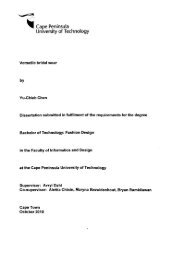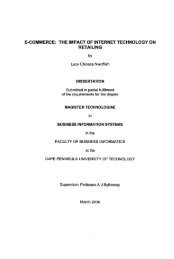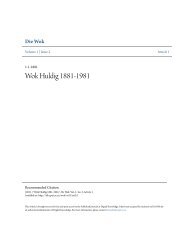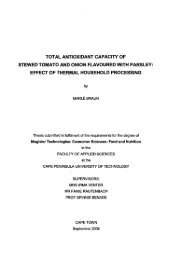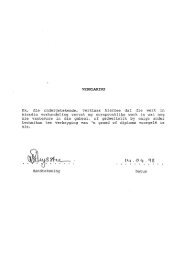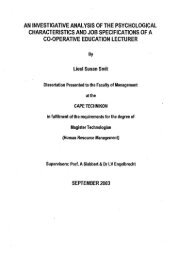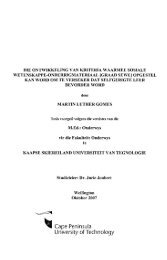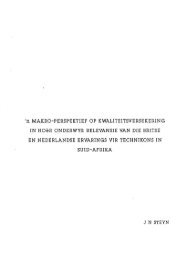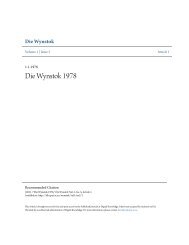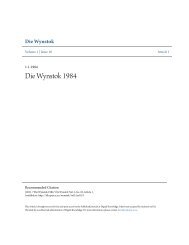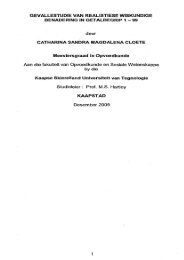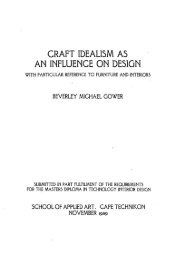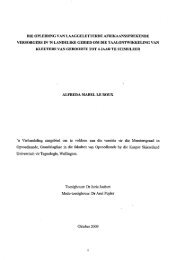the effect of the particle size distribution on non-newtonian turbulent ...
the effect of the particle size distribution on non-newtonian turbulent ...
the effect of the particle size distribution on non-newtonian turbulent ...
You also want an ePaper? Increase the reach of your titles
YUMPU automatically turns print PDFs into web optimized ePapers that Google loves.
Chapter 2 Literature Review<br />
• ..Page<br />
2.20<br />
Figure 2.8: Magnified view <str<strong>on</strong>g>of</str<strong>on</strong>g> a rough pipe wall showing <str<strong>on</strong>g>the</str<strong>on</strong>g> viscous sub-layer<br />
and <str<strong>on</strong>g>the</str<strong>on</strong>g> slurry <str<strong>on</strong>g>particle</str<strong>on</strong>g>s<br />
The Blasius equati<strong>on</strong> is applicable to <str<strong>on</strong>g>the</str<strong>on</strong>g> range 3000 < Re < 100 000 where,<br />
f = 0,079 Reo. 25 • (2.28)<br />
Knudsen & Katz (1958) proposed a similar equati<strong>on</strong> for fully developed <strong>turbulent</strong> Newt<strong>on</strong>ian<br />
flow supposedly applicable to <str<strong>on</strong>g>the</str<strong>on</strong>g> range 5000. < Re < 200 000 where,<br />
f = 0,046 Reo. 2 •<br />
(2.29)<br />
Equati<strong>on</strong> 2.29 is about 10% below equati<strong>on</strong> 2.28 at low Reynolds numbers but meets it at<br />
higher Reynolds numbers (Bowen, 1961). A logarithmic plot <str<strong>on</strong>g>of</str<strong>on</strong>g>f vs Re (Figure 2.8) for <str<strong>on</strong>g>the</str<strong>on</strong>g><br />
above equati<strong>on</strong>s yields a straight line and over <str<strong>on</strong>g>the</str<strong>on</strong>g> years evidence has supported this single<br />
line correlati<strong>on</strong>. For example, Cadwell & Babbitt (1941), who studied <str<strong>on</strong>g>the</str<strong>on</strong>g> flow <str<strong>on</strong>g>of</str<strong>on</strong>g> muds,<br />
Sludges and suspensi<strong>on</strong>s in circular pipes c<strong>on</strong>cluded that head loss in <str<strong>on</strong>g>the</str<strong>on</strong>g> <strong>turbulent</strong> flow<br />
regime can be calculated from <str<strong>on</strong>g>the</str<strong>on</strong>g> Blasius equati<strong>on</strong> if<str<strong>on</strong>g>the</str<strong>on</strong>g> density <str<strong>on</strong>g>of</str<strong>on</strong>g> <str<strong>on</strong>g>the</str<strong>on</strong>g> slurry and a proper<br />
viscosity (defined under larninar flow c<strong>on</strong>diti<strong>on</strong>s) are used.<br />
The v<strong>on</strong> Karmen equati<strong>on</strong> (1930) based <strong>on</strong> <str<strong>on</strong>g>the</str<strong>on</strong>g> Prandtl (1926) mixing length model was<br />
proposed to represent moreexactly <str<strong>on</strong>g>the</str<strong>on</strong>g> experimental data for Reynolds numbers for <str<strong>on</strong>g>the</str<strong>on</strong>g> range<br />
3000 < Re < 300 000 where,



